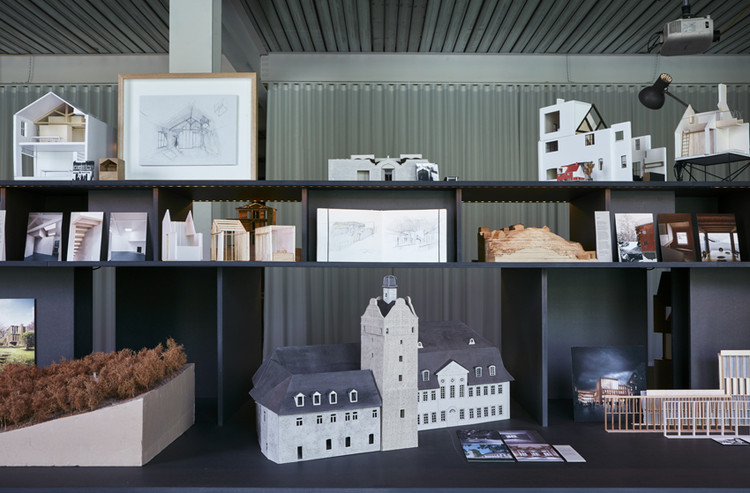
In Granary Square, located in London’s King’s Cross, there is a fragment of the poem Brill by Aidan Dunn set into the ground, which reads: “King’s Cross, dense with angels and histories. There are cities beneath your pavements, cities behind your skies.” Anchored by the converted granary building and a rejuvenated stretch of canal, Argent’s ongoing King’s Cross development is an appropriate setting for Building on the Built, an exhibition which presents the work of London-based practice Jonathan Tuckey Design.
They are currently working on the interiors for Gasholders London, a collection of luxury residential buildings set within the iron skeletons of three gasometers – each having been relocated within the King’s Cross development site. In the latter stages of construction, these iconic Victorian structures and the houses within are visible from the exhibition space, with a 1:20 model of Jonathan Tuckey’s gasholder interiors in the foreground.

The exhibition is framed around the context of the opposing approach to restoration of Eugène Viollet-le-Duc and John Ruskin. While the likes of Viollet-le-Duc believed restorative or additive work on existing buildings should allow for them to “attain a state of completion” John Ruskin, for example, espoused the notion of repair rather than restoration of older buildings and the visual expression of the layering of history within them.
Ruskin’s approach is more evident in the work of Jonathan Tuckey, which is characterized by sensitive yet contemporary insertions into existing settings. Collage House, for example, is the conversion of a steel fabricator’s house into a home in which the texture of the retained brick walls and the structure of the trussed roof are integrated into the architecture. The palimpsest of the original building is celebrated, evoking Ruskin’s “walls that have long been washed by the passing waves of humanity.”[1]

Fred Scott, who tutored Jonathan Tuckey on the interior design course in Kingston University in London, describes the work of intervention as “a dialogue across time between successive generations of designers, and as such as work in continuous progress.”[2] The theme of time is integral to the exhibition. Buildings outlive people and, from the moment an architect hands a building over to a client, their creations take over a life of their own. Walls are shifted, extensions added and users change as a result of fluctuating social and economic forces. In several of the domestic projects, scars from buildings’ former lives are retained and contrasted with contemporary interventions.
Inspired by Joseph Gandy’s painting Public and Private Buildings Executed by John Soane, the exhibition displays an assortment of models spanning the last fifteen years. Fragments of projects at different scales give a sense of the practice’s evolution over time and create a variegated topography akin to the agglomeration of buildings in a city. Although principally involved with domestic projects for private clients, there is an engagement with wider urban conditions in much of the practice’s work.

Meticulous large-scale site models combined with rigorous historical research provide clues to the design. In the ongoing Hackney Road project, a 17th century coach house was discovered in a courtyard behind the main road. This historic building once flanked a Roman road which has now been engulfed by development. The project makes a virtue of this historical condition, creating an intimate courtyard around which the new housing is centred. The exhibition text talks about “exterior interiors” and several of the projects on display carve out civic external spaces. Through small scale interventions, the Wilberforce Primary School project reimagines an existing narrow alleyway as a place for learning, while unrealised projects in Folkestone aim to stitch together the urban grain, creating new routes through the town and opening up “backlands.”
While the majority of the exhibition is concerned with refurbishment, two new build projects are particularly engaging in their attempt to evoke the layering of forms and spaces that characterize historic buildings: a house in the South Downs and a hotel in Costa Rica. On a rural hillside in West Sussex, the proposed house at Quellhurst is conceived as a series of volumes which Jonathan describes as ‘appearing to have arrived at different times’. While there was no existing building to work with, the artificial terracing of the site influenced the design, a reminder that landscapes can have the same layering of history and memory as urban environments.

Joseph Gandy’s famous 1830 painting Soane’s Bank of England as a Ruin in a state of decay was part of a pre-Victorian fascination with ruins. Jonathan Tuckey’s ongoing project for a new boutique hotel in Costa Rica is designed with its future as an overgrown ruin in mind. Deep arched colonnades have a timeless quality reminiscent of Geoffrey Bawa’s Kandalama Hotel in Sri Lanka. Once again, the work is infused with the spirit of Ruskin: “there is not a cluster of weeds growing in any cranny of ruin which has not a beauty in all respects nearly equal, and, in some, immeasurably superior, to that of the most elaborate sculpture of its stones.”[3] Jonathan Tuckey Design’s work develops its richness from the addition of new layers into the life of existing buildings, and for designing with the future life of his buildings in mind. This engaging exhibition is highly recommended.

You can find out more about the exhibition, which runs until the 18th May at 6-8 Stable Street in King’s Cross (London N1C 4AB), here.
References
[1] Ruskin, John. “The Lamp of Memory” in The Seven Lamps of Architecture. (New York: Crowell, 1890) 190.
[2] Scott, Fred. "On Architectural Recycling", Architecture Today (02/11/2008), accessed 04/05/2016.
[3] Wheeler, Michael and Whiteley, Nigel, The Lamp of Memory: Ruskin, Tradition, and Architecture, (Manchester: Manchester University Press, 1992) 86
























